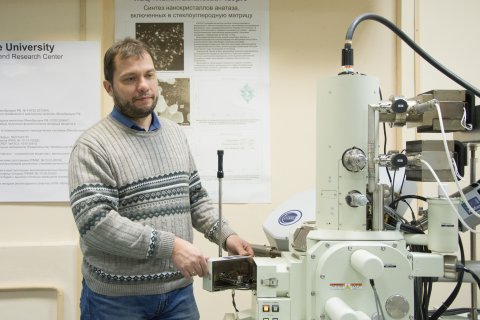Researchers from South Ural State University have patented a new method of obtaining carbon materials based on a mesh structure with a high nitrogen content. This is of interest for application in electrochemistry for the manufacture of innovative filters and sorbents for cleaning liquids and gasses.
In the last 15-20 years, a new field has been developing in organic chemistry related to the creation of covalent organic frameworks (COF). This field has the potential for rapid development in the coming decade and promises many interesting discoveries. By adjusting the pore size of mesh structures, researchers can create innovative filters that prevent the penetration of harmful substances. This can be used for the manufacture of a new generation of sorbents. Such mesh structures are irreplaceable when creating innovative sensor materials.
An example of a covalent organic mesh structure [J. Guo et al. Nature Communications. 4:2736]
Synthesis of New Molecules
A unique feature of covalent mesh structures is that they have a developed system of pores and can be used for the creation of sensors for gasses and liquids, adsorbents for the storage of gases, molecular sieves for separating gas mixtures, and catalyst carriers. Researchers of the SUSU Nanotechnology Research and Education Centre have set the task of creating a material that is pure carbon with an ordered mesh structure. The group is headed by Dmitriy Zherebtsov, senior researcher of the Department of Materials Science and Materials Engineering, engineer of the Nanotechnology REC.
“Like any organic synthesis, the creation of a new molecule always has a certain difficulty. You must choose the conditions for performing of the required reactions: solvents, temperatures, catalysts. Each covalent organic mesh is a new organic compound, and in the majority of cases, chemists synthesize new building blocks for each compound. In and of itself, this block is a new molecule. To obtain it, you must complete a multi-stage synthesis process,” said Dmitriy Zherebtsov.

Materials for Modern Filters
Today, one of the most popular materials in science is graphene, which can be considered a film with a width of just one atom. But graphene mesh from carbon atoms is very dense and is not suitable for the creation of filters, while many covalent organic mesh compounds have graphite-like layered structures with ordered porosity.
“No molecule can pass through a sheet of graphene, because the gap between the atoms of carbon is smaller than the size of any other molecule. But, as soon as we increase the pores in this graphene sheet to 0.5 nm, water molecules, carbon dioxide gas, oxygen, nitrogen, hydrogen, and any other diatomic gasses will be able to pass through, but larger molecules such as benzene or even larger molecules of protein or biological objects (viruses, for example) cannot. The very thin and quite strong mesh layers, which can be obtained in the future from covalent organic meshes, can work as filters or membranes for cleaning liquids and gasses,” said Dmitriy Zherebtsov.
One more important example of the application of covalent organic mesh structures is the storage of gas under pressure. For example, hydrogen cars need to store and transport hydrogen. Hydrogen is very inconvenient to transport at its liquefaction temperature of 20°K, so one of the applications of covalent mesh structures is filling a cylinder to store hydrogen with a highly-porous adsorbent with a developed surface. On the surface of the mesh structure, under the pressure of 150 atm, it can adsorb 5-7% of the hydrogen mass, which is promising for technical use.
World-class Work with Organic Mesh Structures
The topic of creating covalent organic mesh is closely related to the synthesis of aromatic, polycyclic compounds.
“Our research is unique in that we do not just want to create 2 or 3 new types of covalent organic mesh structures, but to make them of carbon completely – both the building blocks and the bridges between them. This will allow us to obtain a principally new material: after creating the organic mesh structure fully of carbon, we are planning on heating it to 1000 °С without introducing air, thereby creating a new, carbon crystal structure. In other words, we want to discover a new class of crystal forms of carbon. This has never been done before, and we hope to be the first,” said Dmitri Zherebtsov, confidently.
Thanks to the competitiveness enhancement programme (Project 5-100) being fulfilled, the SUSU team has had the opportunity to invite a young, highly-qualified specialist from India – Sakthi Dharana, who is working at the Nanotechnology REC for the second year now. In 2018, 3 joint publications were released in the Moscow and international journals. Two more papers are undergoing peer review for the Acta Crystallographica and Journal of Thermal Analysis and Calorimetry.
In completing research in collaboration with the researcher from India, SUSU was able to develop a new method for introducing nitrogen atoms into the structure of a graphite-like carbon material, that is, a method of alloying carbon with nitrogen. This method is characterize by the slow heating of the mixture of pitch and melamine to 500°С, followed with its calcination. Reaching a high content of nitrogen while maintaining a high level of conductivity will make it possible to use the new material in electrodes for electrochemical devices, like batteries, for example.





